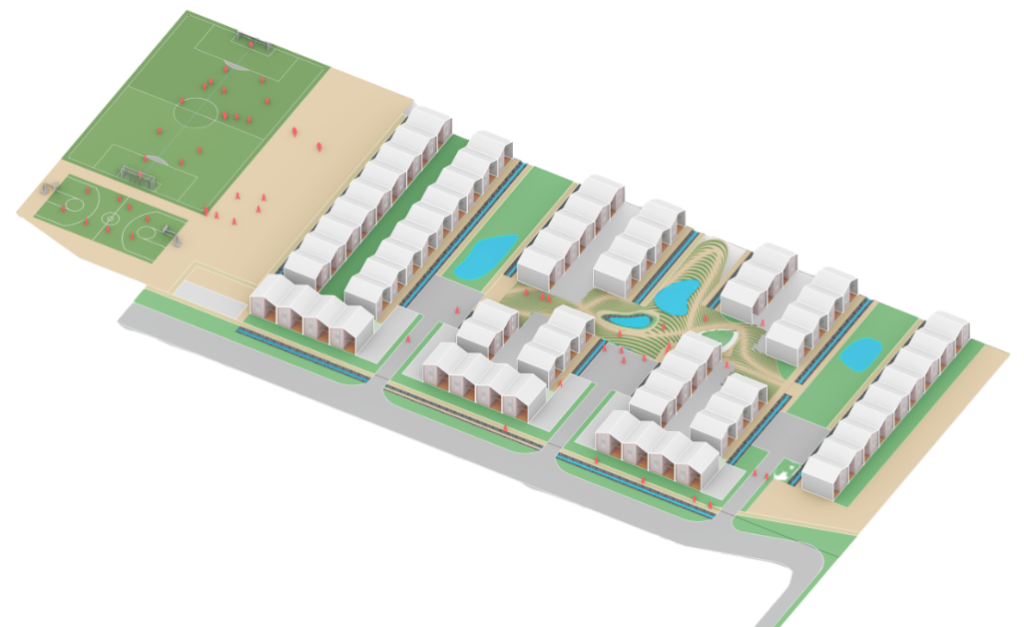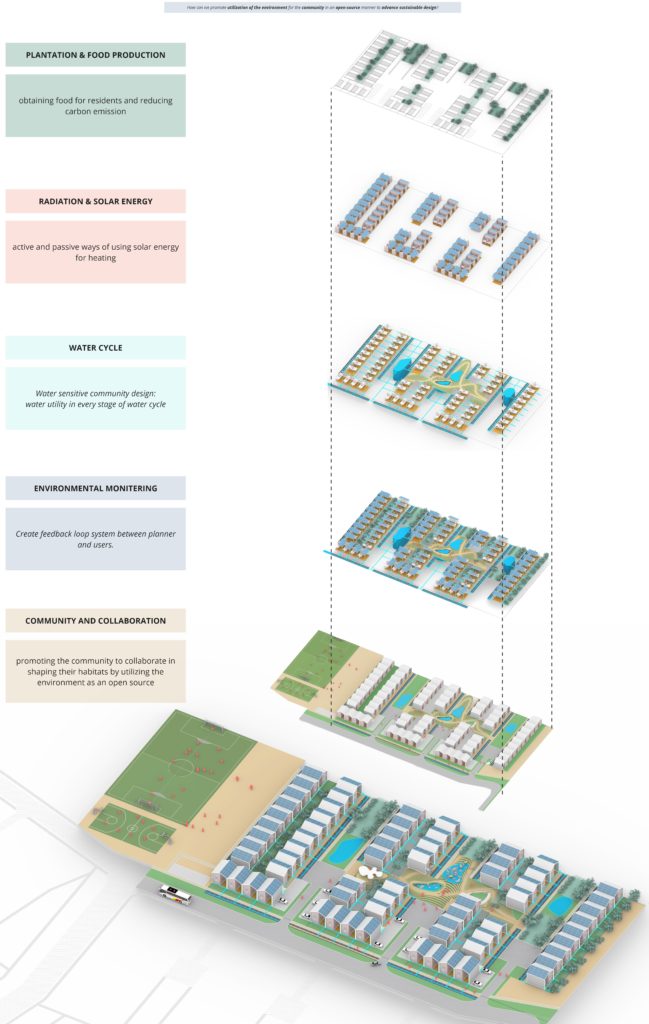Group 09 – Open source architecture – By Yichen Lu , Hande Karata? , Naveen Kumar , Manolya Nielsen
How can we promote the utilisation of the environment for the community, in an open-source manner, to advance sustainable design?
In order to dwell into our research question, we must first define what it is that we want to sustain, and what it is about open source that we are trying to represent. The open source we know today emerged in the 1980s as a way to share technological information and commercial software. This means that the design process, source files, and documentation were open and accessible to the public. Currently some of the well known open source softwares include Firefox, Python, and Blender, as freely accessible design tools for usage, modification and distribution. Over time open source has evolved into a movement that tries to respond to common problems, triggering a community driven exchange of ideas. This interconnectivity harnesses a collective intelligence that can be reflected back into open source designs, including new advancements such as computational tools to monitor and analyse open data.
Figure 1: Interrelation between the Concepts of “Open Source”, “Community-Driven” and “Sustainability”
Within sustainability, environmental, social and economic aspects of communities are at its core. We believe open source design has the ability to provide for these multiple kinds, whilst analysing how they interact for future improvements. It proves a hierarchical relationship as the sustainability of one leads to the sustainability of the other. This relationship however poses the question if certain types of open source data have different priorities or values of sustainability, and what about open source properly embodies the values of openness, collaboration and community?
Open Source Recipes
Throughout history we believe open source has been an approach in design that was only digitalized in the late 1900’s. Previously, it was the utilisation of natural resources and sharing of experiences from the environment which created what we like to call “recipes”, of open source design. As one of the first known examples, the use of natural design ideologies in the Villa Rotonda by Andrea Palladio, known as the Climate Machine. The recipes we have continued to look into are open source as a free access tool for design, a participatory revolutionising approach, and as a guideline or policy for emergent urbanism.
Figure 2: Villa Rotonda, Palladio. Park, Hyoung-June. “Parametric Variations of Palladio’s Villa Rotonda.” International Journal of Architectural Computing 6 (2008): 145 – 169.
Open Data Urbanism
In 2016 the firm Elemental released the rights to four of their social housing projects, and all documents were uploaded for public use to start a movement in which designers would work together to tackle the world’s challenges around housing shortages, post disaster response and increased migration. Using one of the social housing projects “Villa Verde” by Elemental as a foundation, we decided to propose a workflow strategy to build a sustainable settlement through five layers of transformative change. Within the settlement we take into account different layers of environmental approaches democratised by a given strategy by choosing to treat the environment as an open source, and harnessing the inherent elements of nature.
Figure 3: Villa Verde, Elemental
Plantation and Food Production
In the first layer, “Plantation and Food Production,” we focus on achieving self-sufficiency while minimising carbon emissions. We strategically position plantation areas throughout the settlement, ensuring that each housing unit has convenient access to food production. This not only promotes sustainability but also creates a sense of shared responsibility and connection to the land.

Radiation and Solar Energy
In order to make usage of the most efficient and available resource, we decided to place PV panels on the optimally angled roofs of the houses. This adds on to our idea of self sufficiency as each house can cover a portion of their energy consumption just by the use of solar panels, promoting the utilisation of our environment.

Wind and Water Cycle
We introduced “Water Sensitive Urban Design (WSUD)“ into our open source system. Utilising water resources in every stage of the water cycle in a decentralised way, including using natural soil and plant processes to manage stormwater, promoting water reuse and creating urban water bodies not only to recharging water storage but also for urban cooling effect by interacting with wind flow, at the same time activating urban public space.

Environmental Monitoring
Community-Based environmental monitoring engages community members in the monitoring process and produces research outcomes which stakeholders perceive as more legitimate and relevant results. It can be a powerful and inexpensive tool for land-use planning as well as maintaining urban livability to evaluate potential environmental crises. However, lacking policy and guidelines; high reliance on volunteers, and lack of standardised methods will be the challenging issues.

Community and Collaboration
One can note that the open-source movement’s ethics and practices of sharing information and resources to solve common problems are ‘breaking out’ of the digital realm and into the physical world, not only in the urbanist realm but also simply in schemes for sharing goods and space.
By doing things oneself and/or collectively, such as growing food, building, self-organising work, or creating urban commons in terms of open space, we connect environmental ethics together and can further naturally create and improve public space.


Conclusion
The combination of sustainability and open source design aligns with principles of responsible resource use, community collaboration, and accessibility. Together, they offer a framework for creating designs that address environmental and social issues while promoting transparency and inclusivity in the design process. By creating a framework that acts as the ‘source code’ from which a settlement can grow, we believe our open data urbanism strategy will enhance the existing settlement plan to foster greater interconnections between housing units and streets. To create a community that thrives on interaction and collaboration, laying the groundwork for a vibrant and interconnected living experience.
In the future however, one can argue if such open source urban strategies will be able to retain their integrity to answer what crisis may come our way, or if it will sulk into a new age industrial revolution. The digital revolution of having too much uncontrolled and unfiltered data would require more policies and guidelines to be placed for our framework to thrive in future generations.
Reference
- https://www.researchgate.net/publication/359556031_Open_Source_Architecture_and_Environmental_Improvement_Potentials
- https://www.openbuildinginstitute.org/about-what-we-do/
- http://archdaily.com/786528/why-aravenas-open-source-project-is-a-huge-step-toward-better-cheaper-housing-for-everyone?ad_medium=widget&ad_name=recommendation
- https://www.domusweb.it/en/opinion/2011/06/15/open-source-architecture-osarc-.html
- https://www.youtube.com/watch?v=13KtKUfYGGI&t=40s
- https://www.ted.com/talks/cameron_sinclair_my_wish_a_call_for_open_source_architecture?language=en
- https://opensource.com/article/23/1/open-source-sustainability
- https://www.youtube.com/watch?v=Iu7cSt-HE7g
- https://opensource.com/article/22/1/open-source-eco-friendly
- https://www.trigyn.com/insights/embracing-fiware-power-open-source-smart-city-and-iot
- https://www2.deloitte.com/xe/en/insights/industry/public-sector/inclusive-smart-cities.html?site=insights-global-en
- https://opensource.com/article/22/3/open-source-project-sustainability
- https://www.hassellstudio.com/conversation/open-source-city
- https://www.youtube.com/watch?app=desktop&v=6NnunYPWsMA&ab_channel=UVASchoolofArchitecture
- https://www.gaiaguy.com/blogs/news/open-source-sustainable-architecture

